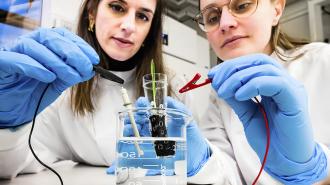A new electrically conductive “eSoil” could make hydroponic farming even more productive — and help ensure a sustainable new source for the human food supply.
“[W]e can get seedlings to grow faster with less resources,” said Eleni Stavrinidou, leader of the Linköping University team that developed the new substrate.
The challenge: Much of the world is perpetually in a food crisis. An estimated 735 million people experienced chronic undernourishment in 2022, a number that has increased by 122 million since 2019, a major setback after decades of progress. The struggle to expand food supply is likely to face new stresses in the future.
“The world population is increasing, and we also have climate change,” said Stavrinidou. “So it’s clear that we won’t be able to cover the food demands of the planet with only the already existing agricultural methods.”
“We can’t say that hydroponics will solve the problem of food security, but it can definitely help.”
Eleni Stavrinidou
The idea: Hydroponic farming — a technique where plants are grown in water rather than soil — could help the world meet some of its future food needs.
Not only does it enable farming in places that lack arable land, hydroponic systems can also be paired with lights to grow plants indoors. Trays of crops can then be layered vertically, allowing more food to be grown in an area than would be possible with traditional farming.
“We can’t say that hydroponics will solve the problem of food security, but it can definitely help, particularly in areas with little arable land and with harsh environmental conditions,” said Stavrinidou.
The biggest challenge with indoor hydroponic farming is the cost — it’s far cheaper to let the sun provide light than it is to power LEDs — so finding ways to make the process more efficient is key to helping it meet its potential.
What’s new? Stavrinidou’s team has now developed a new substrate for hydroponic farming. This is the material the plants’ roots attach to in a hydroponic system, instead of soil, and the standard option is mineral wool, which is made through an energy-intensive process.
The new substrate, called “eSoil,” is made out of cellulose, a material found in plant walls, and PEDOT, an electrically conductive polymer.
This conductivity made it possible to apply a small voltage to the roots of barley plants growing in the substrate. That electrical stimulation made the plants grow 50% larger (by dry weight) than control seedlings grown in eSoil with no stimulation during a 15-day study.
The cold water: This isn’t the first study to show that electrical stimulation can help plants grow. However, the Linköping team says previous studies have used higher voltages, while their eSoil requires a low voltage and has a very low energy consumption, which could make it more practical.
Because the controls were also grown in eSoil without electrical stimulation, though, it’s not clear how this approach compares to barley grown in a traditional substrate. The study also ended while the plants were still seedlings, so more research is needed to test the longer term impact of the eSoil and stimulation.
Looking ahead: The next step for the Swedish scientists will be figuring out how their approach works so that they can further optimize it for use during hydroponic farming.
“We don’t yet know how it actually works [or] which biological mechanisms that are involved,” said Starvrinidou. “What we have found is that seedlings process nitrogen more effectively, but it’s not clear yet how the electrical stimulation impacts this process.”
We’d love to hear from you! If you have a comment about this article or if you have a tip for a future Freethink story, please email us at tips@freethink.com.
